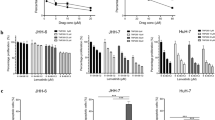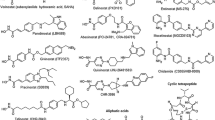Summary
The activity of the histone deacetylase inhibitor PXD101 was investigated in three hepatocellular carcinoma (HCC) cell lines. PXD101was found to inhibit cell growth at a dose-dependent manner and induce histone acetylation in PLC/PRF/5, Hep3B and HepG2 cells. In PLC/PRF/5 and Hep3B cells which express hepatitis B-related genes (HBx, HBc and HBc), treatment with PXD101 resulted in apoptosis without a significant effect on viral gene expression. Exposure to PXD101 for up to 48 h had varying effects on the expression of 12 cellular genes with tumor suppressor functions, including p21, SOCS1, CMTM5, RASAL1, DLEC1, SFRP (-1, -2, -4 and -5), ADAMTS (-8 and -9). This study provided the basis for a phase II clinical trial of PXD101 in inoperable hepatitis-B associated HCC.




Similar content being viewed by others
References
Bosch FX, Ribes J, Diaz M, Cleries R (2004) Primary liver cancer: worldwide incidence and trends. Gastroenterology 127(5):S5–S16. doi:10.1053/j.gastro.2004.09.011
Kremsdorf D, Soussan P, Paterlini-Brechot P, Brechot C (2006) Hepatitis B virus-related hepatocellular carcinoma: paradigms for viral-related human carcinogenesis. Oncogene 25(27):3823–3833. doi:10.1038/sj.onc.1209559
Roncalli M, Bruni B, Laghi L, Destro A, Di Gioia S, Gennari L, Tommasini M, Malesci A, Coggi G (2002) Methylation framework of cell cycle gene inhibitors in cirrhosis and associated hepatocellular carcinoma. Hepatology 36(2):427–432. doi:10.1053/jhep.2002.34852
Schagdarsurengin U, Wilkens L, Steinemann D, Flemming P, Kreipe HH, Pfeifer GP, Schlegelberger B, Dammann R (2003) Frequent epigenetic inactivation of the RASSF1A gene in hepatocellular carcinoma. Oncogene 22(12):1866–18710. doi:10.1038/sj.onc.1206338
Nomoto S, Kinoshita T, Kato K, Otani S, Kasuya H, Takeda S, Kanazumi N, Sugimoto H, Nakao A (2007) Hypermethylation of multiple genes as clonal markers in multicentric hepatocellular carcinoma. Br J Cancer 97(9):1260–1265. doi:10.1038/sj.bjc.6604016
Yoshikawa H, Matsubara K, Qian GS, Jackson P, Groopman JD, Manning JE, Harris CC, Herman JG (2001) SOCS-1, a negative regulator of the JAK/STAT pathway, is silenced by methylation in human hepatocellular carcinoma and shows growth-suppression activity. Nat Genet 28(1):29–35. doi:10.1038/88225
Matsumura T, Makino R, Mitamura K (2001) Frequent down-regulation of E-cadherin by genetic and epigenetic changes in the malignant progression of hepatocellular carcinomas. Clin Cancer Res 7(3):594–599
Chiba T, Yokosuka O, Arai M, Tada M, Fukai K, Imazeki F, Kato M, Seki N, Saisho H (2004) Identification of genes up-regulated by histone deacetylase inhibition with cDNA microarray and exploration of epigenetic alterations on hepatoma cells. J Hepatol 41(3):436–445. doi:10.1016/j.jhep.2004.05.018
Dannenberg L, Edenberg HJ (2006) Epigenetics of gene expression in human hepatoma cells: expression profiling the response to inhibition of DNA methylation and histone deacetylation. BMC Genomics 7:181. doi:10.1186/1471-2164-7-181
Venturelli S, Armeanu S, Pathil A, Hsieh CJ, Weiss TS, Vonthein R, Wehrmann M, Gregor M, Lauer UM, Bitzer M (2007) Epigenetic combination therapy as a tumor-selective treatment approach for hepatocellular carcinoma. Cancer 109(10):2132–2141. doi:10.1002/cncr.22652
Qian X, LaRochelle WJ, Ara G, Wu F, Petersen KD, Thougaard A, Sehested M, Lichenstein HS, Jeffers M (2006) Activity of PXD101, a histone deacetylase inhibitor, in preclinical ovarian cancer studies. Mol Cancer Ther 5(8):2086–2095. doi:10.1158/1535-7163.MCT-06-0111
Tumber A, Collins LS, Petersen KD, Thougaard A, Christiansen SJ, Dejligbjerg M, Jensen PB, Sehested M, Ritchie JW (2006) The histone deacetylase inhibitor PXD101 synergises with 5-fluorouracil to inhibit colon cancer cell growth in vitro and in vivo. Cancer Chemother Pharmacol 60(2):275–283. doi:10.1007/s00280-006-0374-7
Plumb JA, Finn PW, Williams RJ, Bandara MJ, Romero MR, Watkins CJ, La Thangue NB, Brown R (2003) Pharmacodynamic response and inhibition of growth of human tumor xenografts by the novel histone deacetylase inhibitor PXD101. Mol Cancer Ther 2(8):721–728
Seng TJ, Low LS, Li H, Cui Y, Goh HK, Wong ML, Srivastava S, Sidransky D, Califano J, Steenbergen RD, Rha SY, Tan J, Hsieh WS, Ambinder RF, Lin X, Chan AT, Tao Q (2007) The major 8p22 tumor suppressor DLC is frequently silenced by methylation in both endemic and sporadic nasopharyngeal, esophageal and cervical carcinoma. Oncogene 26(6):934–944
Chiba T, Yokosuka O, Fukai K, Kojima H, Tada M, Arai M, Imazeki F, Saisho H (2004) Cell growth inhibition and gene expression induced by the histone deacetylase inhibitor, trichostatin A, on human hepatoma cells. Oncology 66(6):481–491. doi:10.1159/000079503
Herold C, Ganslmayer M, Ocker M, Hermann M, Geerts A, Hahn EG, Schuppan D (2002) The histone-deacetylase inhibitor Trichostatin A blocks proliferation and triggers apoptotic programs in hepatoma cells. J Hepatol 36(2):233–240. doi:10.1016/S0168-8278(01)00257-4
Pathil A, Armeanu S, Venturelli S, Mascagni P, Weiss TS, Gregor M, Lauer UM, Bitzer M (2006) HDAC inhibitor treatment of hepatoma cells induces both TRAIL-independent apoptosis and restoration of sensitivity to TRAIL. Hepatology 43(3):425–434. doi:10.1002/hep.21054
Laurent-Puig P, Zucman-Rossi J (2006) Genetics of hepatocellular tumors. Oncogene 25(27):3778–37860. doi:10.1038/sj.onc.1209547
Herath NI, Leggett BA, MacDonald GA (2006) Review of genetic and epigenetic alterations in hepatocarcinogenesis. J Gastroenterol Hepatol 21(1 Pt 1):15–21. doi:10.1111/j.1440-1746.2005.04043.x
Georgiadis KE, Hirohata S, Seldin MF, Apte SS (1999) ADAM-TS8, a novel metalloprotease of the ADAM-TS family located on mouse chromosome 9 and human chromosome 11. Genomics 62(2):312–315. doi:10.1006/geno.1999.6014
Lo PH, Leung AC, Kwok CY, Cheung WS, Ko JM, Yang LC, Law S, Wang LD, Li J, Stanbridge EJ, Srivastava G, Tang JC, Tsao SW, Lung ML (2007) Identification of a tumor suppressive critical region mapping to 3p14.2 in esophageal squamous cell carcinoma and studies of a candidate tumor suppressor gene, ADAMTS9. Oncogene 26(1):148–157. doi:10.1038/sj.onc.1209767
Jin H, Wang X, Ying J, Wong AH, Cui Y, Srivastava G, Shen ZY, Li EM, Zhang Q, Jin J, Kupzig S, Chan AT, Cullen PJ, Tao Q (2007) Epigenetic silencing of a Ca(2+)-regulated Ras GTPase-activating protein RASAL defines a new mechanism of Ras activation in human cancers. Proc Natl Acad Sci U S A 104(30):12353–12358. doi:10.1073/pnas.0700153104
Wakabayashi K, Saito H, Kaneko F, Nakamoto N, Tada S, Hibi T (2005) Gene expression associated with the decrease in malignant phenotype of human liver cancer cells following stimulation with a histone deacetylase inhibitor. Int J Oncol 26(1):233–239
Ying J, Srivastava G, Gao Z, Zhang X, Murray P, Ambinder R, Tao Q (2004) Promoter hypermethylation of the cyclin-dependent kinase inhibitor (CDKI) gene p21WAF1/CIP1/SDI1 is rare in various lymphomas and carcinomas. Blood 103(2):743–746. doi:10.1182/blood-2003-09-3193
Shih YL, Hsieh CB, Lai HC, Yan MD, Hsieh TY, Chao YC, Lin YW (2007) SFRP1 suppressed hepatoma cells growth through Wnt canonical signaling pathway. Int J Cancer 121(5):1028–1035. doi:10.1002/ijc.22750
Lee JL, Chang CJ, Wu SY, Sargan DR, Lin CT (2004) Secreted frizzled-related protein 2 (SFRP2) is highly expressed in canine mammary gland tumors but not in normal mammary glands. Breast Cancer Res Treat 84(2):139–149. doi:10.1023/B:BREA.0000018412.83348.ff
Shao L, Cui Y, Li H, Liu Y, Zhao H, Wang Y, Zhang Y, Ng KM, Han W, Ma D, Tao Q (2007) CMTM5 exhibits tumor suppressor activities and is frequently silenced by methylation in carcinoma cell lines. Clin Cancer Res 13(19):5756–5762. doi:10.1158/1078-0432.CCR-06-3082
Qiu GH, Salto-Tellez M, Ross JA, Yeo W, Cui Y, Wheelhouse N, Chen GG, Harrison D, Lai P, Tao Q, Hooi SC (2008) The tumor suppressor gene DLEC1 is frequently silenced by DNA methylation in hepatocellular carcinoma and induces G1 arrest in cell cycle. J Hepatol 48(3):433–441. doi:10.1016/j.jhep.2007.11.015
Xiong Y, Dowdy SC, Podratz KC, Jin F, Attewell JR, Eberhardt NL, Jiang SW (2005) Histone deacetylase inhibitors decrease DNA methyltransferase-3B messenger RNA stability and down-regulate de novo DNA methyltransferase activity in human endometrial cells. Cancer Res 65(7):2684–2689. doi:10.1158/0008-5472.CAN-04-2843
Duan HHC, Boxer LM (2005) Histone deacetylase inhibitors down-regulate bcl-2 expression and induce apoptosis in t(14;18) lymphomas. Mol Cell Biol 25(5):1608–1619. doi:10.1128/MCB.25.5.1608-1619.2005
Wu CG, Forgues M, Valerie K, Farnsworth J, Markin RS, Wang XW (2001) Distinctive gene expression profiles associated with Hepatitis B virus x protein. Oncogene 20(28):3674–3682. doi:10.1038/sj.onc.1204481
Park IY, Yu E, Suh DJ, Chung YH, Lee JH, Surzycki SJ, Lee YI (2007) Aberrant epigenetic modifications in hepatocarcinogenesis induced by hepatitis B virus X protein. Gastroenterology 132(4):1476–1494. doi:10.1053/j.gastro.2007.01.034
Chen JY, Lee CS, Chen DS, Zuckerman AJ, Harrison TJ (1988) Detection of hepatitis B virus DNA in hepatocellular carcinoma: methylation of integrated viral DNA. J Virol Methods 19(3):257–263. doi:10.1016/0166-0934(88)90020-1
Miyoshi E, Fujii J, Hayashi N, Ueda K, Towata T, Fusamoto H, Kamada T (1992) Enhancement of hepatitis-B surface-antigen expression by 5-azacytidine in a hepatitis-B-virus-transfected cell line. Int J Cancer 52(1):137–140. doi:10.1002/ijc.2910520124
Yeo W, Chan PK, Zhong S, Ho WM, Steinberg JL, Tam JS, Hui P, Leung NW, Zee B, Johnson PJ (2000) Frequency of hepatitis B virus reactivation in cancer patients undergoing cytotoxic chemotherapy: a prospective study of 626 patients with identification of risk factors. J Med Virol 62(3):299–307. doi:10.1002/1096-9071(200011)62:3<299::AID-JMV1>3.0.CO;2-0
Yeo W, Ma B, Hui P, Chan L, Mo F, Yu S, Ho S, Koh J, Chan AT, Goh B (2007) A phase I/II study of belinostat (PXD101) in patients with unresectable hepatocellular carcinoma. ASCO Annual Meeting Proceedings Part I 25(18S):15081
Acknowledgements
This study was sponsored by the Cancer Therapy Evaluation Program of the National Cancer Institute (Bethesda, USA). Result of this study was presented as a poster at the 98th American Association of Cancer Research annual meeting in April 2007, Los Angeles; abstract number 2494. This study was funded by the Direct Grant of the Chinese University of Hong Kong (Reference 2005.1.018), and the Li Ka Shing Institute for Health Sciences.
Author information
Authors and Affiliations
Corresponding author
Rights and permissions
About this article
Cite this article
Ma, B.B., Sung, F., Tao, Q. et al. The preclinical activity of the histone deacetylase inhibitor PXD101 (belinostat) in hepatocellular carcinoma cell lines. Invest New Drugs 28, 107–114 (2010). https://doi.org/10.1007/s10637-009-9219-7
Received:
Accepted:
Published:
Issue Date:
DOI: https://doi.org/10.1007/s10637-009-9219-7




